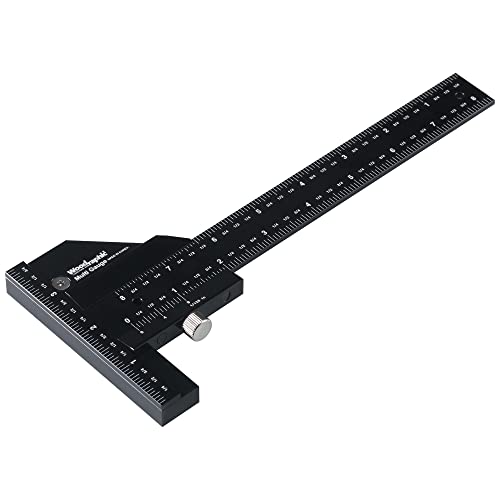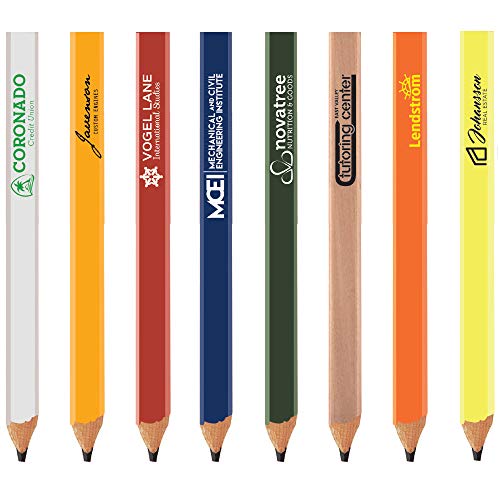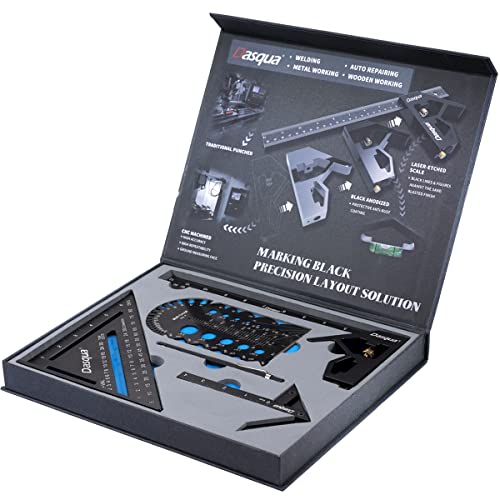


When it comes to working with wood, a carpenter’s pencil is an essential tool. These pencils are specifically designed for carpentry work, with a flat shape and durable construction. But a common question that arises is whether these pencils contain lead.
The good news is that carpenter pencils do not contain lead. In fact, lead has been phased out of pencils for several decades now. Instead, carpenter pencils are made with a graphite core, which is a safer alternative to lead. Graphite is a non-toxic material that is commonly used in pencils, as it allows for smooth and precise markings on various surfaces.
Although carpenter pencils are free from lead, it is important to note that they are still not intended for consumption. Just like any other pencil, accidentally ingesting particles of the pencil can be harmful. Therefore, it is always best to handle carpenter pencils with care and avoid putting them in your mouth.
So, if you’re a carpenter or simply someone who enjoys woodworking, you can rest assured that the carpenter pencils you use do not contain lead. These pencils are specifically designed to meet the needs of carpentry work, providing you with a reliable tool without the worry of harmful lead exposure.
The Use of Carpenter Pencils in Construction
Carpenter pencils are an essential tool in the construction industry. They are specifically designed to meet the unique needs of carpenters and other construction professionals. These pencils are longer and thicker than regular pencils, making them easier to grip and handle. The larger size also allows for a more durable and long-lasting pencil.
One of the key features of carpenter pencils is their flat shape. The flat surface prevents the pencil from rolling off of surfaces and provides stability when marking measurements or drawing lines. This feature is particularly important when working on uneven surfaces or in challenging conditions.
Marking and Measuring
Carpenter pencils are primarily used for marking and measuring in construction projects. The flat lead of the pencil allows for precise and accurate lines to be drawn on various materials, including wood, concrete, and metal. These marks serve as guides for cutting, drilling, and assembling materials, ensuring accuracy and minimizing errors.
Additionally, carpenter pencils often have two different types of leads. One side may have a graphite lead, which is suitable for marking on lighter materials, while the other side may have a colored lead, such as red or yellow, which is more visible on darker surfaces.
Durability and Versatility
Carpenter pencils are known for their durability. The thick lead resists breakage and can withstand the demands of construction work. Additionally, some carpenter pencils feature a retractable lead, protecting it from damage when not in use.
Moreover, carpenter pencils can be used in various weather conditions, including hot and cold environments. The lead does not smudge or fade easily, allowing for clear and visible markings even in adverse conditions. This versatility makes carpenter pencils a reliable tool for construction professionals working in different climates and settings.
In conclusion, carpenter pencils are an indispensable tool in the construction industry. Their unique design and features make them ideal for marking and measuring in construction projects. The durability, stability, and versatility of these pencils contribute to their widespread use among carpenters and other professionals in the field.
Importance of Lead-free Products
Lead-free products have become increasingly important in recent years due to the potential health risks associated with lead exposure. Lead is a toxic heavy metal that can have severe effects on human health, especially in children and pregnant women.
Exposure to lead can lead to a range of health problems, including neurological and developmental issues. In children, lead exposure can cause learning disabilities, lower IQ, and behavioral problems. Pregnant women who are exposed to lead may experience complications, including low birth weight and developmental delays in their babies.
By using lead-free products, such as carpenter pencils, we can help minimize the risk of lead exposure. These pencils are specifically manufactured without lead and are a safer alternative for both professionals and homeowners alike.
Furthermore, using lead-free products ensures that we are not contributing to lead pollution. When lead-based products are disposed of improperly or end up in landfills, they can contaminate soil and water sources. This contamination can have far-reaching effects on ecosystems and the health of both humans and wildlife.
Benefits of lead-free products:
- Health protection: Lead-free products reduce the risk of lead exposure and associated health problems.
- Environmental responsibility: By choosing lead-free products, we contribute to a cleaner and safer environment.
- Safe for children: Lead-free products are particularly important for children, who are more vulnerable to the harmful effects of lead.
- Compliance with regulations: Many countries have strict regulations regarding lead content in products to protect consumers’ health. By using lead-free products, we comply with these regulations.
Conclusion
In conclusion, lead-free products, such as carpenter pencils, are essential for maintaining the health and safety of individuals and the environment. By choosing lead-free options, we can minimize the risk of lead exposure and contribute to a cleaner and healthier world.
What Are Carpenter Pencils
Carpenter pencils are a specialized type of pencil that are commonly used by carpenters, construction workers, and other professionals in the building trades. Unlike regular pencils, carpenter pencils have a unique design that sets them apart.
One of the key features of carpenter pencils is their shape. They are typically larger and thicker than regular pencils, with a rectangular or oval cross-section. This shape makes them easier to hold and more comfortable to use for extended periods of time. The larger size also means that they can be easily found in a toolbox or on a jobsite.
Another distinctive feature of carpenter pencils is their lead. Rather than using traditional graphite, carpenter pencils are typically filled with a harder, stronger lead that is specifically designed for rough surfaces like wood or concrete. This allows carpenters to make bold, visible marks that can be easily seen, even on rough or textured materials.
Durable and Versatile
Carpenter pencils are known for their durability, which is an essential trait for tools used in construction and woodworking. The harder lead and sturdy construction of the pencil make it resistant to breakage, even when subjected to rough handling or accidental drops.
Specially Designed Features
In addition to their shape and lead, carpenter pencils often include other features that make them even more versatile. For example, some pencils have a flat or beveled edge that can be used for marking straight lines or making precise measurements. Others may have a built-in pencil sharpener to ensure that the lead is always ready for use.
Overall, carpenter pencils are a valuable tool for professionals in the building trades. Their unique design, durable construction, and specialized lead make them ideal for making accurate and visible marks on a variety of surfaces.
Characteristics of Carpenter Pencils
Carpenter pencils are specialized tools that are designed for use in woodworking and construction. These pencils have unique characteristics that make them well-suited for these industries:
Durable Design
Carpenter pencils are typically made with a strong, solid core that can withstand the rigors of woodworking and construction. This makes them less prone to breakage compared to regular pencils.
Flat Shape
One distinctive characteristic of carpenter pencils is their flat shape. This shape prevents the pencil from rolling away when placed on an inclined surface, making them easier to handle and reducing the risk of accidents.
The flat shape also allows carpenter pencils to be easily held in place behind the ear or tucked into a pocket or tool belt, providing convenience and accessibility for workers.
Wide Lead
Carpenter pencils typically have a wide lead that is thicker than that of regular pencils. This wider lead allows for bold and conspicuous markings, making them highly visible on various surfaces, including wood, concrete, and other construction materials.
The wide lead of carpenter pencils also makes them suitable for rough and uneven surfaces, as they are less likely to break or wear down easily.
In conclusion, carpenter pencils are a durable and practical choice for professionals in the woodworking and construction industries. Their durable design, flat shape, and wide lead contribute to their functionality and effectiveness in making visible markings on various surfaces.
Materials Used to Make Carpenter Pencils
Carpenter pencils are essential tools for professionals in the woodworking and construction industries. These specialized pencils are designed to withstand the demands of rugged environments and provide accurate and reliable markings on various materials.
Several materials are used to make carpenter pencils, ensuring their durability and functionality. These materials include:
Wood
Wood is the primary material used for the body of carpenter pencils. It is crucial to choose a strong and resilient wood that can withstand constant use and pressure. Many manufacturers use high-quality cedar wood for its durability and ability to sharpen easily. Cedar wood is known for its natural resistance to decay and insects, making it an ideal choice for carpenter pencils.
Lead Core
The lead core is an essential component of carpenter pencils. Contrary to popular belief, carpenter pencils do not contain actual lead. Instead, they use a special graphite mixture that offers excellent marking qualities. This graphite mixture is harder and more durable than traditional pencil lead, making it perfect for rough surfaces and heavy-duty applications.
| Material | Description |
|---|---|
| Wood | The primary material used for the body of carpenter pencils. Provides durability and strength. |
| Graphite Mixture | An alternative to lead, the graphite mixture offers excellent marking qualities on various materials. |
Overall, the materials used to make carpenter pencils ensure their longevity and performance in demanding work environments. The combination of strong wood and a specialized graphite mixture makes carpenter pencils reliable tools for professionals in the field.
Lead Exposure Risks
Lead exposure can pose serious health risks to individuals, particularly children and pregnant women. It is important to be aware of potential sources of lead contamination to minimize exposure and protect your health.
Sources of Lead Exposure:
- Older homes built before 1978 may have lead-based paint on walls, windows, and doors.
- Drinking water can be contaminated if it travels through lead pipes or plumbing fixtures.
- Soil can be contaminated with lead from old paint, past use of leaded gasoline, or industrial pollution.
- Some imported ceramic dishes and pottery may contain lead in the glaze.
- Lead-based cosmetics and traditional remedies can also be sources of lead exposure.
- Occupational exposure can occur in industries such as manufacturing, construction, and battery recycling.
- Lead can be present in certain consumer products, including toys, jewelry, and imported candies.
Health Effects of Lead Exposure:
Lead exposure can have long-term detrimental effects on both physical and cognitive development, especially in children. Some health issues associated with lead exposure include:
- Decreased IQ and cognitive impairments
- Learning disabilities and behavioral problems
- Growth retardation
- Hearing loss
- Kidney damage
- Reproductive issues
It is important to take precautions to reduce lead exposure, such as regular handwashing, keeping living environments clean, and avoiding products containing lead. If you suspect lead contamination, it is recommended to consult with a professional for testing and remediation.
Health Effects of Lead Exposure
Lead exposure can have serious health effects, especially on children.
When lead enters the body, it can affect the central nervous system, leading to behavioral and developmental problems. Children who are exposed to lead may have lower IQ scores, decreased attention span, and learning difficulties.
Lead can also harm the kidneys, liver, and reproductive system. It can interfere with the production of red blood cells and cause anemia. In high levels, lead exposure can even cause seizures, coma, and death.
Lead poisoning can occur through various sources, including contaminated soil, water, dust, and certain consumer products, such as carpenter pencils.
Although carpenter pencils contain a form of lead known as graphite, the risk of lead exposure from using these pencils is considered low. The lead content in carpenter pencils is typically much lower than in traditional lead pencils, and the graphite is not easily absorbed by the body.
However, it is still important to practice good hygiene when using carpenter pencils or any other potentially lead-containing products. Wash your hands thoroughly after use, and avoid touching your mouth, face, or food while using these products.
If you suspect lead exposure or are concerned about the potential health effects, it is best to consult a healthcare professional for advice and guidance.
| Health Effects of Lead Exposure |
|---|
| Behavioral and developmental problems in children, such as lower IQ scores and learning difficulties. |
| Harm to the kidneys, liver, and reproductive system. |
| Interference with red blood cell production, leading to anemia. |
| Potential for seizures, coma, and death in high levels of exposure. |
Regulations on Lead Levels in Products
Lead is a highly toxic element that can have serious health effects, especially in children. Due to its harmful nature, there are strict regulations in place to limit the amount of lead allowed in products.
In the United Kingdom, the Trading Standards Institute (TSI) is responsible for enforcing these regulations. They have set specific limits on lead levels in various products to ensure consumer safety.
- Toys and children’s products: The TSI limits the lead content in toys and children’s products to 90 parts per million (ppm). This level is considered safe for children to handle and play with.
- Building materials: Lead-based paint and other building materials must comply with the European Union’s Construction Products Regulation. This regulation sets a maximum limit of 90 ppm for lead content in these products.
- Food and beverage containers: The Food Standards Agency (FSA) regulates the lead levels in food and beverage containers. The specific limits vary depending on the type of material used, but they are designed to ensure that lead does not leach into the food or drink.
<li<Imported goods: The TSI also monitors and tests imported goods for lead content. If a product exceeds the allowable limit, it may be banned from the market or subjected to recall.
It is important for manufacturers and suppliers to adhere to these regulations to protect consumers from potential lead exposure. Regular testing and quality control measures can help ensure compliance with the specified lead limits.







